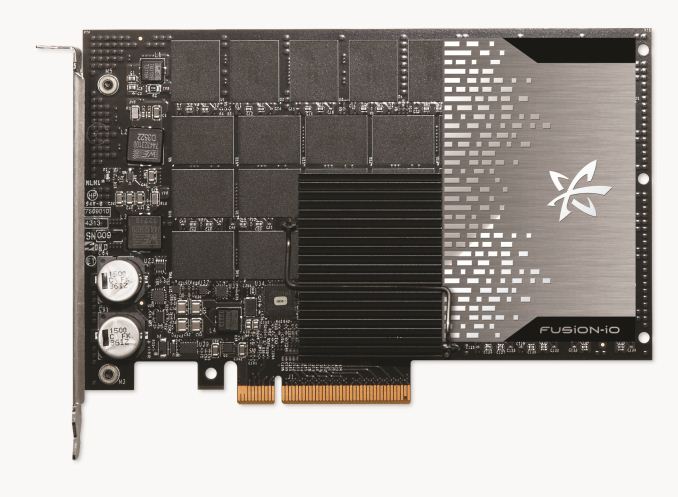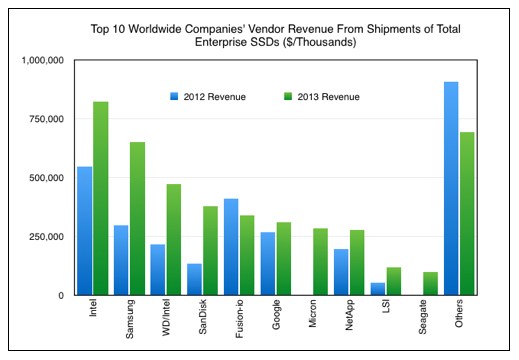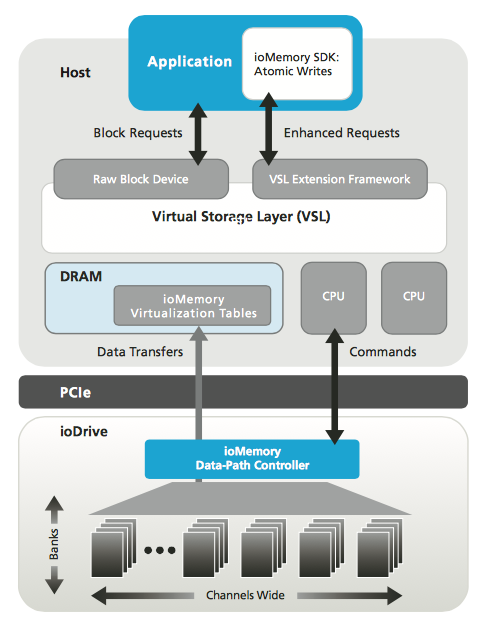The State of SanDisk
by Kristian Vättö on December 5, 2014 8:00 AM ESTThe Enterprise
In mid-July SanDisk announced their acquisition of Fusion-io and the acquisition was completed a couple of week prior to Flash Memory Summit. I posted my initial thoughts when the news hit the public, but I feel that it's worth doing a bit deeper analysis now that I have given it some more thought and discussed it with John Scaramuzzo, senior vice president and general manager of SanDisk's enterprise business.
SanDisk has managed to establish itself as one of the key players in the enterprise SSD space over the past few years. The acquisitions of Pliant in 2011 and SMART Storage Systems in 2013 provided SanDisk with strong expertise and product lineups for SATA and SAS SSDs but left the company without a solid long-term plan for PCIe. I heard Pliant's initial roadmap included plans for PCIe-based solutions as well, but it looks like those plans never materialized.
Up until the Fusion-io acquisition, the Lightning PCIe SSA was the only PCIe solution in SanDisk's enterprise product portfolio, and as a matter of fact that drive is internally a SAS-based design with a PCIe to SAS bridge onboard. In other words, SanDisk had practically zero real PCIe solutions for the enterprise, while at the same time SanDisk's biggest competitors, such as Intel and Samsung, have had PCIe drives for a long while already.
Fusion-io's 3.2TB Atomic Series SSD
Fusion-io's strategy and product portfolio, on the other hand, was a complete opposite. From the beginning Fusion-io has focused on PCIe storage, which dates all the way back to 2007 when the company released its first ioDrive that utilized a PCIe x4 interface and was capable of speeds up to 800MB/s. Not only was Fusion-io early in the market, but the company was also able to garner a few massive and very important clients – the most notable being Facebook and Apple. I don't think it's an overstatement to say that Fusion-io can be considered as the pioneer of PCIe storage because it was the first company to turn PCIe SSDs and storage in general into a large, successful business.
But stories eventually come to an end. The competitive advantages Fusion-io had were its PCIe technology and several high-level customers, but the advantages were lost when the NAND manufacturers stepped into the PCIe territory. It's nearly impossible for a company that has to source its NAND from a third party to compete against another company that manufactures NAND in-house since the latter will always have advantages in cost. While Fusion-io didn't lose its customers to competitors overnight, it's clear that especially Intel and Samsung snagged a share of Fusion-io's business in the past couple of years.
In a nutshell, the acquisition brings SanDisk the long-needed expertise in PCIe storage along with Fusion-io's broad PCIe product portfolio. The acquisition is now a bit over 100 days in and the Fusion-io employees have been integrated into SanDisk's existing teams. Initially Fusion-io's engineering team was separate and worked under Lance Smith, the former President and COO of Fusion-io, but Mr. Smith decided to leave SanDisk and pursue other options. Last week a data virtualization startup Primary Data announced that Mr. Smith has joined the company as the new CEO, which explains his quick departure from SanDisk.
All the engineering talent has now been unified and the team is lead by Mr. Scaramuzzo. With everyone under the same roof, the roadmaps are now in the process of being integrated to bring the expertise together. It will be a while before we see the fruits of the acquisition, but in the meantime the latest Fusion-io products will transition to SanDisk NAND for increased cost efficiency.
But what about NVMe? That has been the hot topic in the industry this year and I bet many of you are wondering what is SanDisk's and Fusion-io's play in that field. The short version of their strategy is that Fusion-io already has a technology called Virtual Storage Layers (VSL), which is essentially a driver/software stack similar to NVMe. The truth is that NVMe isn't really anything new from a technology perspective, but what makes it alluring for many manufacturers is the fact that the NVMe drivers are universal and already supported by the latest operating systems. Technologies like VSL are rather expensive to develop and require expertise because there is no framework available (i.e. everything has to be developed from scratch), but on the other hand an in-house driver like VSL allows for more customization and optimization.
However, that doesn't mean that SanDisk has no interest on NVMe whatsoever. The company sees that as the entry and mid-level enterprise SSDs move from SATA and SAS to PCIe, NVMe will be one of the key factors because of easy and quick deployment. For that market segment the NVMe spec and its limitations are fine – it's only the high-end segment where the benefits of VSL are more prominent. It's actually likely that many manufacturers will turn to custom NVMe drivers anyway for higher and more optimized performance, and in fact that is already happening with Intel providing its own NVMe driver for the P3600/P3700.
Lastly, let's quickly discuss the ULLtraDIMM. I wrote a quick piece on ULLtraDIMM right after Flash Memory Summit, but SanDisk has already scored Huawei as the third ULLtraDIMM partner (in addition to IBM and Supermicro). The first generation product that is currently available is internally based on a pair of SATA 6Gbps controllers, but SanDisk said that a native DDR to NAND controller is possible in the future if the market adopts the new form factor well. As usual, the industry is fairly slow in adopting new form factors, so it's hard to say whether NAND DIMMs will really take off, but it's a very interesting and potentially useful technology.
Final Words
All in all, SanDisk is definitely one of the most interesting NAND companies going forward. USB drives, eMMC solutions, SSDs and even the storage arrays from the Fusion-io acquisition are all built on NAND, which puts SanDisk in a unique position as it's the only NAND manufacturer that focuses solely on NAND products. The company can't turn to alternative revenue sources like e.g. Intel and Samsung can, but on the other hand that's also SanDisk's strength as all the know-how and experience in the company is related to NAND in one way or the other.
Ultimately next year will be crucial for SanDisk because it determines whether the company can materialize all the underlying potential from the Fusion-io acquisition and become a serious competitor to Intel and Samsung in the enterprise space. The pieces are definitely there, so it's just a matter of execution now.














132 Comments
View All Comments
Negger - Saturday, December 6, 2014 - link
If companies like Sandisk want to grow their market share they need to provide better support to their end users. I have yet to see Sandisk provide a 2.5 to 3.5 bracket with an SSD, even though it's a $1 part with free shipping on ebay. Look at the crummy software Sandisk gives with their SSDS. The Sandisk SSD Dashboard is among the worst I have ever seen on Windows. It requires a minimum screen resolutions, it really shouldn't for what it actually does. It doesn't accurately detect firmware updates, and erroneously marks older drives bad. Sandisk is also extremly slow to provide firmware updates to their SSDs. It took six months to fix a TRIM error bug that was well documented and I get the feeling the only reason they bothered patching it was because of customer uproar on their forums and other forums. Sandisk seems to orphan their older SSDs in terms of firmware, and the overall experience buying a Sandisk product is underwhelming. The packaging feels like a small deck of playing cars and the labeling itself looks no-name. Put a holographic sticker or something on it for chrissake so it doesn't look so much like an off-brand. I realize most of Sandisk's customers are large OEMs and wholesalers, but the end user experience is what will drive the sales. There is a lot of weight in IT hobbyist and professional channels and their brand loyalty, many companies live or die by their reputation.jameskatt - Saturday, December 6, 2014 - link
Interesting. Consumers - other than Apple customers - can't get SSDs because Manufacturers don't want to risk their bottom of the barrel profit margins by using higher dost SSDs.The only way SSD manufacturers can get more SSDs used is to:
1. Increase Apple computer sales
2. Lower SSD prices more to the point that they are equivalent to hard drive prices.
Duken4evr1 - Saturday, December 6, 2014 - link
It is an admittedly smaller market perhaps, but SSDs make wonderful upgrades for older computers and particularly laptops. Older laptops with a C2D processor are "enough" for most users, even though they are 7 years old. The laptop I am typing this on is a 7 year old Lenovo R61 with an SSD in it. Gotta love the old Lenovos, they are built like tanks. Adding an SSD to Windows 7 and 4GB of RAM to the old workhorse makes it more responsive than my new work provided i5 laptop with a mechanical hard drive. Thus fortified, the old Lenovo workhorse will probably run another 8 years.PubFiction - Saturday, December 6, 2014 - link
One of the biggest problems with OEM SSD adoption is that OEMs simply do not offer well configured laptops. What I mean is they have purposely screwed over medium level laptops to try to force people up into higher end laptops. This technique is called upselling. Almost every manufacturer does this. And the same exact problem also applies to other components. We as enthusasts often know what a good value setup is. IE one that cost a moderate amount of money but gives you good bang for your buck. Interestingly go see if you can configure any major OEMs laptop to look like what you would pick. I bet you will find it hard or not possible at all. Instread you will be forced to upgrade past what you want to something higher for a lot more money.Now if you want to upgrade to an SSD the next problem is that it will cost you an arm and a leg that doesn't even make sense. If and SSD is selling for $100 one newegg the OEM will charge you $150 or more to upgrade. The kicker is they take your hard drive away. So it didn't cost them $150 to give you that SSD in fact they should be buying it cheaper they just made a lot more profit lets say $90, and they paid $50 for the hard drive so the net difference is $40 but instead of charging you $60 or $80 for the upgrade they screw you over with a $150 upgrade. As long as OEMs keep trying to milk higher profit out of upgrades people are going to be shy about it. OEMs are still tying to make SSDs a feature of premium upgrades and as long as they continue that SSDs will not deploy as mainstream.
Cerb - Sunday, December 7, 2014 - link
"What is it that we or manufacturers like SanDisk could do to boost the SSD penetration in the market?"Having not read any other comments: get PC OEM's heads collectively out of...um, the sand. Yeah, the sand :). Apple seems to be the only one with sense (hmm, and look at their sales and margins...coincidence?). Even if you want an SSD, many series won't have the option, or the cost will be outrageous for the size, as an upgrade. Where I work, we're buying SSDs separately, and cloning the HDDs, after resizing the partitions, because the cost difference is just so huge, and/or an SSD is not an option at all, and/or an SSD will add weeks of delay to shipping. Much like a better display, I see no good reason for SSDs, if not in a base model, to not at least be in each middle tier and higher of any given series. At our normal prices, the costs are less than double that of an HDD, typically.
Users may appreciate one once they get it, but they don't have a clue about the technology, and most I deal with don't want to get one. They just want it to work, and be faster than their old one. The demo systems at places like Best Buy need to have them , at the least, but to make them sing and dance, they also need to not have all the regular junk software running. An HDD system of similar specs beside it might be good, too. Some users will always get cheap, but others simply aren't going to pay extra for a smaller drive, when they don't see why they might want it.
Christopher33 - Sunday, December 7, 2014 - link
"This is actually the part where we ask for your, our readers, help. What is it that we or manufacturers like SanDisk could do to boost the SSD penetration in the market?"I've bought 1TB EVO 840, and I would never, ever made such mistake again. I would buy 840 PRO 512 instead, and currently I'm searching for old SSDs, that had very short access times. My Dell's PM 830 (830 Sammy) 128GB is "doing circles" while EVO (yes... after FW update) is noticeably slower (yes, I am VM user). I'm currently looking only into consumer SLC (4KB 1QD super high IOPS) SSDs like Fujitsu FSXtreme 240GB SLC. EVO managed SSD-like bechavior only for a month. TLC is not (and never will be) and option for enthusiast.
Primum - Sunday, December 7, 2014 - link
My office has only just picked up its first two desktops with SSDs from Dell. They've been given to the serial offenders who forget to save things to the server and save everything locally. The solution? Tiny SSDs (120GB or less I think) to encourage them to do so. Sadly despite asking since I started I'm still on a 5400rpm HDD. Average start up time (to a point where work can happen): 5 minutes. The one they just replaced took closer to 10 minutes. I got in a full round of drinks for everyone before it started up most days.Zertzable - Sunday, December 7, 2014 - link
I believe the biggest barrier is actually OEMs.Pair a Core i3 with a 128/256GB SSD and, for the vast majority of mainstream users, it'll feel far better than an i7 with a huge, slow drive. I'm fairly certain one of the main reason people love their Mac's so much is simply the easy and enormous improvement to UX provided by SSD's. Most people won't notice the crappy build quality and screen, but what they will notice for sure is how slow their brand new laptop is, thanks to that 5400 RPM drive it came with.
The problem? In the mainstream PC space, big numbers and marketing sell. UX isn't even on the radar.
Wwhat - Sunday, December 7, 2014 - link
The only acceptable thing about the current TLC is that its competition drives down the price of real SSD drives.I think though that the manufacturers should be forced to include that a product uses TLC in the name, and have it clearly on the packaging.
Cerb - Sunday, December 7, 2014 - link
No such thing has happened.M500 240GB: $81
MX100 256GB: $105
Ultra Plus 256GB: $102
Ultra II 240GB: $107
840 Evo 250GB: $114
I don't particularly hate TLC, if implemented well (like the Ultra II), but when it can be 40% *MORE* than a similar MLC drive, why on Earth should I bother? It has so far been *MLC* drives, like the M500, and Ultra Plus, helping to drive down prices. TLCs are being sold for the same or higher prices, and have been since the Samsung 840's release. The 840 was not cheap, nor has the 840 Evo been, compared to typical M500 prices. Sandisk followed with lower price with the Ultra Plus. If you didn't catch sales, the 840, 840 Evo, and now Ultra II, have not been lower than other MLC drives, even discounting Sandforce integrators, from release to today.
TLC drives should be 15 or more cheaper, considering every day prices, before I would buy or recommend one to anyone, enthusiast or not. I bought an Ultra II this BF week, for example, and it's a nice snappy little drive. But, I would not have bought it without those sales, because I could get an MLC drive, that I know will *maintain* its access times well, instead (I must admit, Samsung and Sandisk both getting WA down to Sandforce levels, with no compression or dedupe, using pSLC, has basically removed the longevity issues, for all but the top few % of data abusers).